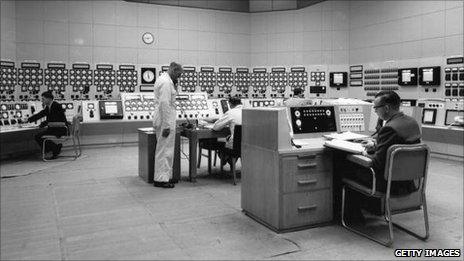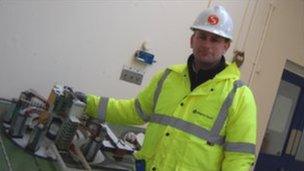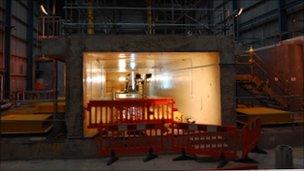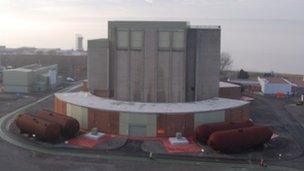Closing the world's first commercial nuclear power station
- Published

Berkeley, seen here in 1963, has now been stripped of its equipment
The Magnox reactor buildings at the world's first commercial nuclear power station stand square, almost defiantly, against the brisk breeze from the River Severn.
Built in the late 1950s, the power station produced enough electricity during its heyday to supply a city the size of Bristol.
These days, devoid of life and stripped of its external pipework, the seven-storey buildings are little more than hollow shells.
"When they were operational they were full, jam packed with gear," says site director Sean Sargent as he surveys one of the large, dark rooms in Reactor 2, the beam from his powerful torch bouncing off the cold concrete floor and walls.
Locked up and sealed

Mr Sargent says 99% of the radioactive waste was sent to Sellafield 20 years ago
Inside the windowless structures, vast concrete chambers, stripped of monitoring and control equipment, surround a central cylinder that houses the old nuclear reactors.
But electricity production at the Berkeley site ceased in the late 1980s, marking the end of just over three decades of supplying the National Grid.
Since then, the reactors have taken on new lives.
These days, following two decades of dismantling and decommissioning, their function is to store the reactor's casing and core.
On Thursday, the buildings will be locked up and sealed for 64 years of nuclear waste storage - allowing the radiation in the reactors to degrade to levels low enough to make it both safe and economic to remove the waste that is still left within them before knocking them down.
"We'll be locking the doors and that'll be it," says Mr Sargent.
Nowhere to put it

Intermediate-level nuclear waste will be recovered from underground vaults and moved to a new site
In nuclear jargon, sealing the buildings is referred to as "entering Safestore"; the second stage in a lengthy process of nuclear power plant decommissioning.
Berkeley is the first of 10 Magnox nuclear power stations in the UK to reach this stage of decommissioning, though they will all follow suit over the years ahead.
Sara Johnston from the Nuclear Decommissioning Authority (NDA) believes this is "demonstrating the progress made in decommissioning".
"This is a hugely significant achievement, not just for the site but for the UK nuclear industry as a whole," she says.
Sceptics, however, believe it highlights how slow the process of dealing with nuclear waste is, and point out that there is more than one reason why the reactor buildings at Berkeley will remain intact for three-quarters of a century after electricity production here came to an end.
One reason is that it is cheaper and just as efficient to leave the contaminated material where it is, rather than build a new storage facility on site.
The other reason is that the UK still has not constructed a geological disposal facility where it can put its radioactive waste.
Nuclear waste

Berkeley nuclear power station ceased producing electricity in 1989
At this point in time, it has not even been decided where the UK's underground nuclear waste repository will be constructed, though somewhere near Sellafield in Cumbria - where the vast bulk of the UK's high-level nuclear waste is currently stored - is generally deemed the most likely location.
This was where the foundations were laid for the construction of Berkeley and the UK's commercial nuclear power industry, when during the late 1950s Calder Hall at Sellafield branched out from nuclear for military purposes to also deliver power to the National Grid.
This is also where spent fuel rods from Berkeley were sent for reprocessing during 1989-1992, so all the active waste - some 99% of all the radioactivity that was here - has long since left the site in Gloucestershire.
But Berkeley has nevertheless been left with about 1,000 tonnes of intermediate-level radioactive waste from its research laboratories, and in the form of sludge from the treatment of the cooling water.
This waste is currently stored below ground in eight-metre deep vaults, each of them six metres wide and 14 metres long.
Like all the contaminated waste in the UK, Berkeley's intermediate-level waste will eventually end up in the planned underground repository, though in the meantime it will be stored on site.
A new storage facility will be created above ground, adjacent to the two reactor-buildings-cum-waste-stores.
"We talk of a three box solution," says Mr Sargent.
Problem for newbuild?
Regulators and local people alike seem satisfied that the storage solutions at Berkeley are safe for now.
But having radioactive waste temporarily stored at old Magnox nuclear power station sites, at a time when plans for the next generation of new nuclear power plants in the UK is being hammered out, could prove problematic for the industry.
Opponents to nuclear power will see it as visible proof that the mess from the past has not been sorted out, thus undermining assurances by the newbuild industry that its radioactive waste will be properly dealt with in the future.
- Published26 October 2010
- Published19 October 2010